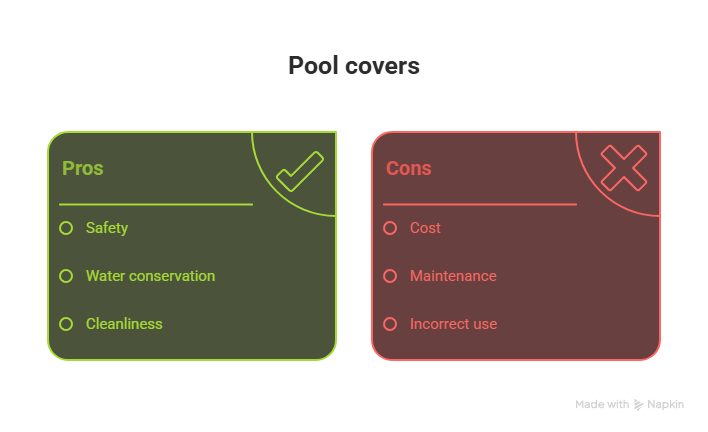Swimming pool covers are essential safety features that every pool owner should understand and use properly. When used correctly, they protect people and pets, conserve water, and keep your pool clean. But did you know they must be used correctly to provide these benefits?

Key Takeaways:
- Complete removal of covers is necessary before swimming to prevent entrapment
- Safety covers must support 485 lbs to meet ASTM standards for rescue scenarios
- Pool covers reduce water evaporation by up to 95%, saving chemicals and money
- Professional measurement ensures proper fit and maximum safety performance
- Regular safety inspections prevent accidents and extend your cover’s lifespan
Why Pool Covers Are Essential for Swimming Pool Safety
The Importance of Proper Cover Removal
Is it safe to swim with a partially removed cover? Absolutely not! Swimming pool safety covers must be completely removed before anyone enters the pool. Partial removal creates dangerous entrapment risks where swimmers could become trapped underneath.
When removing your cover:
- Clear all water or debris from the top first
- Remove systematically from one end
- Store properly away from the pool area
- Train all family members on correct removal procedures
A partially removed cover creates a dangerous “underwater tent” effect that can trap even strong swimmers. Remember: no cover is better than a partially removed cover when the pool is in use.
Creating Safe Access for Swimmers
After removing your swimming pool cover, store it properly away from the pool area to prevent tripping hazards. Consider investing in a swimming pool cover roller which makes removal easier and provides proper storage.
Understanding Pool Cover Safety Standards
Safety standards exist for a reason – they save lives. The ASTM F1346-23 requirements specify that proper safety covers must:
- Support at least 485 lbs (approximately two adults and one child)
- Prevent objects larger than 4 inches from passing through any openings
- Include clear safety labeling on both sides of the cover
- Drain water effectively to prevent dangerous pooling
These requirements aren’t just suggestions – they’re designed to prevent accidents and enable rescues in emergency situations.
Environmental Benefits of Pool Covers
Water Conservation Advantages
Did you know that an uncovered pool can lose over 2cm of water per week through evaporation? Swimming pool covers drastically reduce this water loss, saving approximately 38,000 liters of water annually for an average pool. That’s significant water conservation!
In South Africa, where water restrictions are common, this could save you thousands of Rand in water bills annually.
Chemical and Heat Retention
Pool covers also:
- Reduce chemical consumption by up to 60%
- Maintain water temperature, cutting heating costs
- Decrease the need for frequent water top-ups
This means fewer chemicals needed and lower energy bills – a win for your wallet and the environment.
Selecting the Right Safety Cover
Finding swimming pool covers near me is just the first step. Professional measurement is crucial for safety cover effectiveness. DIY measurements often miss crucial details like:
- Exact dimensions including coping stones
- Decking irregularities that affect anchoring
- Special features requiring custom fitting
| Cover Type | Best For | Maintenance Level |
|---|---|---|
| Mesh Safety | Areas with leaves/debris | Low (allows drainage) |
| Solid Safety | Maximum heat retention | Medium (requires pump) |
| Winter Cover | Seasonal closing | Medium-High |
| Automatic | Convenience | Low (but higher cost) |
Seasonal Maintenance and Inspection
Your swimming pool winter cover needs regular checks to remain effective. Create a seasonal checklist:
- Inspect all anchor points for corrosion
- Check stitching and seams for UV damage
- Test drainage capacity before heavy rain seasons
- Verify that straps maintain proper tension
- Look for tears or holes that could compromise safety
For winter-specific concerns, reinforced webbing systems (typically 3″ straps vs. standard 1.5″ straps) provide extra strength for snow loads.
Supplementary Safety Measures
Safety covers work best as part of a comprehensive safety system. Consider adding:
- Motion-activated alarms
- Pool gate locks
- Clear safety rules for all family members
- Emergency response plan
Keep appropriate tools nearby for emergency access. Sharp tools like shears should be stored in locked containers accessible to adults in case someone becomes trapped under a cover.
Practical Debris Management
One of the biggest benefits of swimming pool covers for sale is their ability to keep debris out. They create an effective surface seal, preventing leaves and dirt from contaminating your pool.
Different cover types handle drainage differently:
- Mesh designs allow rainwater through while blocking debris
- Solid covers require pumps to remove accumulated water
- Swimming pool sump covers help manage drainage effectively
Conclusion
Pool cover safety requires proper installation, consistent usage, and regular maintenance. By following the guidelines in this article, you’ll protect your family, conserve water, and extend your pool’s lifespan while saving money on chemicals and cleaning.